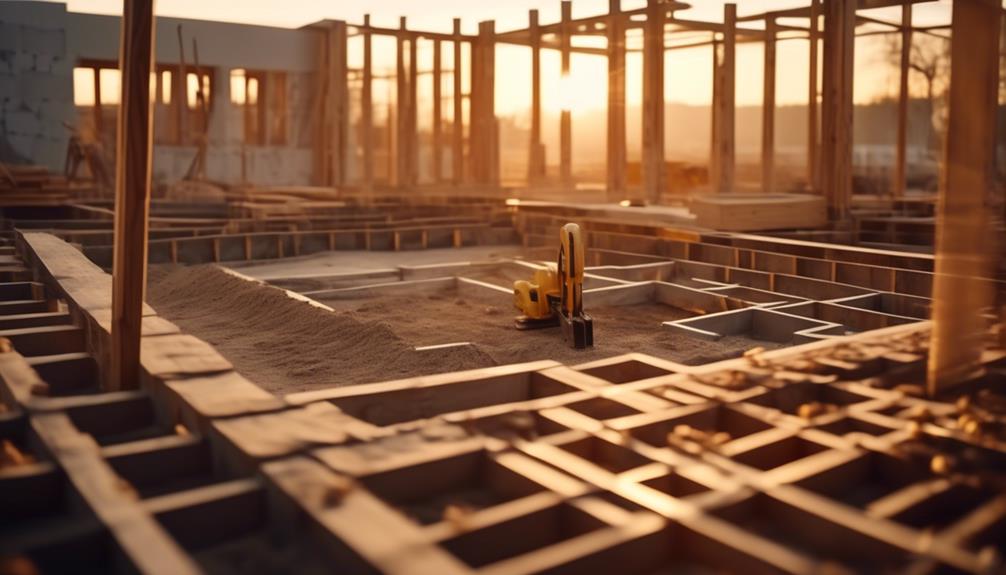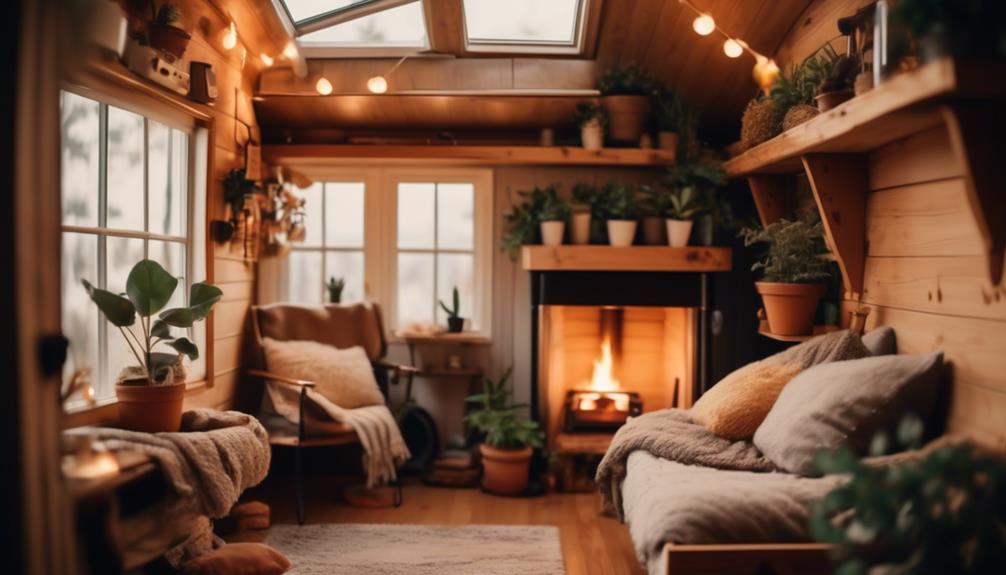While you might worry that constructing a tiny home requires expert carpentry skills, you'll find that with the right guidance, you can assemble a cozy abode tailored to your needs.
As you embark on this journey, you'll discover that it's not just about saving space or money; it's about creating a personalized sanctuary that reflects your values and lifestyle.
You'll need to consider your budget, the tools necessary for the job, and the materials that will make up your home.
In the following steps, we'll walk you through how to lay a solid foundation, both literally and figuratively, for your tiny house.
But remember, the devil is in the details, and it's the nuances of design and decoration that will turn your small space into a home.
So, stick with us, and we'll reveal how to navigate the complexities of building regulations and space optimization to ensure your tiny home is as functional as it is charming.
Key Takeaways
- Establishing a budget is crucial before starting the planning and design process for building a tiny home.
- Maximizing small spaces is essential in tiny home design, and can be achieved through multifunctional furniture, vertical storage, and space-saving solutions.
- Incorporating finishing touches and decor, such as multi-purpose furniture and plants, can enhance the aesthetics and functionality of a tiny home.
- Safety and compliance should be prioritized throughout the construction process, including following building codes, using non-toxic materials, and incorporating security features.
Establishing Your Budget
Before diving into the construction of your tiny home, it's crucial to establish a clear and realistic budget that encompasses land costs, square footage, building expenses, and potential financing options. Researching the total cost to finance your project is vital.
If you're on a tight budget, consider a tiny house kit to save money; custom builds with an architect will increase your spend building. Land and permits can significantly impact the total cost, so explore these early.
Consult professionals to navigate options for financing, whether through traditional loans or alternative methods. Securing your financing before starting, especially for custom features, can save you thousands.
Designing Your Tiny Home
As you design your tiny home, focus on maximizing small spaces through ingenious solutions that enhance functionality without sacrificing comfort.
Selecting a layout that optimizes your living area is crucial; consider foldable, multipurpose furniture and built-ins to utilize every inch effectively.
Your interior design should mirror your personality, integrating aesthetics and practicality to create a space that's both inviting and efficient.
Maximizing Small Spaces
When designing your tiny home, every square inch counts, so it's essential to plan how to maximize your small space efficiently and creatively. The floor plan must be meticulously crafted to ensure that your living space is both functional and inviting. Here are some strategies:
| Maximizing Strategy | Description |
|---|---|
| Multifunctional Furniture | Opt for pieces that serve multiple purposes. |
| Vertical Space Usage | Install shelves and use the height of rooms. |
| Simple Roof Design | A straightforward roof can offer more space. |
In your tiny home build, choose space-saving solutions like stairs that double as storage or ladders to access loft areas. The tiny house interior should embody innovation—think convertible tables and collapsible chairs. Remember, the key is a smart design that makes your home feel larger than its footprint.
Choosing Functional Layouts
Having explored space-maximizing strategies, it's crucial to now focus on selecting a functional layout that enhances the flow and utility of your tiny home. Within the constraints of limited square footage, your house design must integrate multi-functional furniture and embedded storage solutions. This customization is at the heart of the tiny house movement, diverging from traditional home layouts where space is less of a premium.
Strategically position major appliances to support the home's infrastructure, ensuring they're sized to effectively heat and cool your space without excess. Choose a water heater that meets your needs without occupying excessive room. Remember, every inch counts.
Consulting with experts can provide tailored advice, ensuring your custom tiny home boasts functional layouts that epitomize innovation while remaining practical and livable.
Personalizing Interior Design
Embracing your individuality, choose furniture and décor that not only maximize space but also mirror your personal aesthetic, ensuring your tiny home is both a functional dwelling and a reflection of your style.
When building your tiny home, consider the finishing touches that personalize your space. Opt for DIY tiny house solutions that are inventive and space-efficient.
As you build your tiny house, plan for electrical outlets in locations that support your lifestyle, ensuring you can charge devices without clutter.
When you live in a tiny house, every inch counts, so select convertible furnishings that serve multiple purposes. Neutral colors for walls and fabrics can make your tiny house feel more open.
Securing Materials and Tools
Before you start building your tiny home, it's critical to meticulously research and compile a comprehensive list of all materials and tools required for the construction, ensuring you're well-equipped for the project ahead.
When you build a tiny home, aligning with building codes is paramount. Your materials and tools checklist should reflect innovation and precision. Consider the necessity of a vapor barrier or house wrap for moisture control. Roofing material selection will impact longevity and insulation, while windows and doors must balance aesthetics with energy efficiency. The intricacies of plumbing and electrical systems demand specialized tools and knowledge.
| Material/Tool Category | Specific Item |
|---|---|
| Structural | House Wrap |
| Exterior | Roofing Material |
| Openings | Windows and Doors |
| Systems | Plumbing and Electrical Supplies |
Source quality materials from local tiny house specialists and invest in durable tools, ensuring your build is up to the task.
Laying the Foundation

Before you begin constructing your tiny home, you must choose between a permanent foundation or a mobile, trailer-based platform.
If you opt for a fixed location, prepare the site meticulously, ensuring you clear the area and pour a solid, level foundation akin to traditional home construction.
Should you prefer mobility, select a robust tiny house trailer, and take the time to level it precisely, securing it with the appropriate anchors for stability.
Choosing Foundation Type
When planning your tiny home, it's crucial to decide on the foundation type, as this choice will anchor your build and influence both design and mobility. If you're eyeing a permanent foundation, you'll need to clear the area, pour concrete, and comply with zoning laws, treating it like standard home construction. Before you start building, secure financing and find a suitable place to build.
Alternatively, a tiny house trailer offers mobility. Select a model with undercarriage flashing and square fenders for added efficiency. Use jack stands and a level to ensure the trailer is even before you build a tiny house on it. This step-by-step process lays the groundwork for your innovative home on wheels or a fixed location.
Site Preparation Steps
To lay a solid foundation for your tiny home, you must first determine whether you'll anchor it to a permanent spot on land or maintain flexibility with a trailer base. The site preparation steps are crucial and can impact your building experience from start to finish.
Here's what you need to do step-by-step:
- Clear the Build Area: Make sure the land is cleared and level before pouring a permanent foundation.
- Pour the Foundation: Treat this step as you'd with standard new home construction.
- Purchase and Level a Trailer: If you opt for mobility, find a tiny home trailer and ensure it's level, using jack stands and a four-foot level.
- Consider Trailer Features: Look for trailers with undercarriage flashing and square fenders, which can streamline the build process.
Consider hiring a professional to oversee these steps if your plans to build your tiny home require expertise beyond your current skills.
Constructing the Structure
Start by designing your tiny home's structure to suit its intended purpose and reflect your personal style, keeping in mind the choice of a solid foundation, whether stationary or mobile.
Your next step is the actual building phase, where precision and technical know-how come into play. Begin framing the walls, prioritizing durability and support for your tiny house. The roof design should be both functional and aesthetically pleasing, providing protection and complementing the overall style.
Constructing the structure requires meticulous attention to detail—ensure efficient insulation and proper ventilation are integrated to promote energy efficiency and comfort. Innovative, space-saving solutions are key in a tiny home, so plan for versatile furniture and multipurpose areas.
This DIY project is a test of your building prowess, making each step towards a completed structure a significant milestone in your tiny house journey.
Finishing Touches and Decor

Having constructed the sturdy framework of your tiny home, it's now time to infuse it with personality through carefully selected finishes and decor. This final step is where your Tiny Life becomes Big in a Tiny way. The work must be detail-oriented, as every square inch counts.
- Incorporate Multi-Purpose Furniture: Optimize your living space with innovative furniture that doubles as storage.
- Embrace Nature: Decorate with plants to bring a sense of the outdoors inside your compact dwelling.
- Color and Light: Use neutral colors to visually expand the space, adding vibrant accents through textiles.
- Sustainable Energy: Consider installing solar panels on metal roofing, ensuring your tiny abode is energy efficient.
Remember to Insulate Your Tiny home properly before moving on to aesthetic touches like fascia boards and tar paper.
Frequently Asked Questions
How to Build a Tiny House Step by Step for Beginners?
To build a tiny house, you'll design blueprints, choose materials, determine foundation types, frame walls, select roofing and insulation, plan the interior layout, install electrical wiring, understand plumbing basics, and apply exterior cladding.
Is It Cheaper to Build Your Own Tiny House?
Could your dream home cost less than you think? Building your own tiny house often saves on budget considerations, but don't overlook material sourcing, design customization, and time investment against DIY challenges and legal restrictions.
Can I Build a Tiny House by Myself?
You can build a tiny house yourself, tackling DIY challenges with proper tools and materials. Prioritize space optimization, adhere to building codes, and consider climate, sustainability, and off-grid options for innovative design inspiration.
How Do I Prepare for a Tiny House?
To prepare for a tiny house, you'll research site selection, understand legal restrictions, employ downsizing strategies, and choose sustainable materials. Find design inspiration, plan your budget meticulously, assess your skills, gather tool essentials, and consider climate for community living.
Conclusion
You've mastered the art of crafting a tiny haven, turning a kernel of an idea into a magnificent castle on a miniaturized scale. With precision and care, you've navigated budgets, wielded tools like a seasoned artisan, and laid a foundation as solid as your determination.
Your tiny home, a testament to your skill and dedication, stands ready to embrace you. Welcome to a life less ordinary, in a space that's nothing short of extraordinary.

